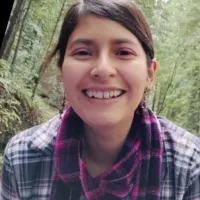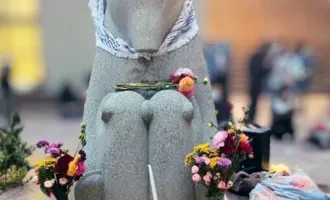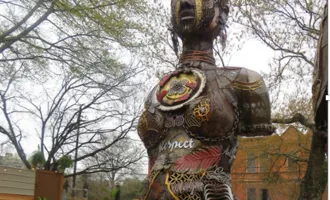
Photo: Giselle Perez-Aguilar
May 2024 Oaxacan wildfire road closures.
Ecological Disaster in LA Highlights Indigenous Firekeeping
After a decade of moving between the Bay Area, the Midwest, and Mexico, in August of last year, I finally moved back to the lively Boyle Heights neighborhood of Los Angeles.
It has been special coming back to the community where I was born and raised, and last week, I finished a full draft of my dissertation entitled Oaxacan Knowledge Keepers, Earth Stewards, and Defenders of Indigenous Healing Systems of Care.
My dissertation is a critical ethnography that explores the revitalization and mobilization of Oaxacan Indigenous healing practices across the U.S. Mexican borderlands.
As a diasporic Xicana-Indigenous woman on these Indigenous lands, I imagined I would be happy once I sent my dissertation’s draft and could rest my right hand which had flared up in pain from the constant typing.
But I wasn’t, because of the wildfires that started across Los Angeles County on Jan. 8. I was getting ready to go to Aztec dance practice when I heard the strong gust of winds coming through. Palm tree leaves covered my home’s driveway and the street. I texted the dance group to see if practice was cancelled and since I didn’t hear back, I headed over.
The winds were powerful, tornado-like in fact. I was pensive throughout the practice, my worries synching to the rhythms and intensity of the drumming. The energy of our prayer in movement to the ancestors was powerful and scary that night. A tornado of dried leaves formed, and we began to smell the smoke coming from the Altadena fire.
As we danced to the powerful winds, thousands of Los Angeles County residents were losing their homes, their communities, their sense of belonging and connection, their peace, and even their lives to the wildfires. It was a sad and tragic day indeed, and still is with the wildfires continuing, and the forces of business-as-usual capitalism clashing with mutual aid support and collective care efforts.
Last year, I conducted my dissertation’s fieldwork in Oaxaca during a severe water crisis. In May 2024, wildfires engulfed parts of the Central Valley and Sierra Norte regions. Local inhabitants of communities impacted took matters into their own hands to challenge government inactions by organizing road closures.
Living through the water crisis and the wildfires in Oaxaca was a humbling experience and opened my perspective on how the ecological crises impacting Oaxacan peoples intertwines with the wildfires in Southern California. Across geographies, Mother Earth screams and awakens an earth-based critical consciousness.
Although the wildfires wreaked havoc on affluent neighborhoods, there are differences among the communities impacted that cannot be overlooked. The Statistical Atlas shows that 83.5% of the population in Palisades is white, 5.2% Latine, 1.4% Black, 4.8% Asian, 4.9% Mixed, and 0.3% other.
In contrast, the racial/ethnic background in Altadena, according to the U.S. Census Bureau, is the following: 46% white, 18% Black, 1.2% American Indian and Alaskan Native, 5.7% Asian, 17.1% Mixed, and 27.2% Latine.
As we continue processing the climate catastrophe of the Southern California wildfires, it is important to look at it through an intersectional, socio-ecological, and intergenerational lens, particularly how race, class, gender, age, disability status, and immigration status shape access to resources and support systems in these trying times and the transgenerational impacts we will see in the long-term.
We must also unravel the responses and actions of the Federal Emergency Management Agency (FEMA), state and local stakeholders of the ecological safety net. As the ecological fire crises build momentum, we are eager for the rains to arrive soon, as were Oaxacan peoples last year, but heavy rains could be destructive.
From an environmental sociological perspective, we cannot overlook the darkness of modernity fueled by the logics of racial-settler capitalism embedded in urban, suburban, and rural life ways, and which threaten the mutualism between human populations and the natural world.
While fossil fuels keep Los Angeles running, the winds and fires have shown us they are stronger than urban and suburban livelihoods.
I send my prayers and loving energy to all those impacted by the wildfires, including the animals, plants, trees, and guardians of Mother Earth’s environments. Los Angeles will recover from the wildfire crisis, I am sure, with the wisdom and protection of the Tongva, Tataviam, Serrano, Kizh, and Chumash ancestors.
Native and Indigenous Peoples of Turtle Island and Abya Yala have restored Indigenous fire keeping since time immemorial and are at the forefront of ecological justice struggles.
In Mesoamerican cosmovision, the sound of a seashell trumpet blower known as a “quiquitztli” represents the element of air/wind in ceremony and healing rituals. When the “quiquizoanis” play their sacred “quiquitztlis” they apologize and express gratitude to the winds, fires, waters, lakes, rivers, oceans, and the Earth.
Indigenous fire-keeping like cultural and controlled burns can save us from future climate catastrophes, but we must listen, honor, and push for environmental and urban planning policy changes.



